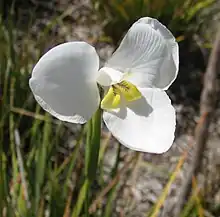| Diplarrena moraea | |
|---|---|
 | |
| Scientific classification | |
| Kingdom: | Plantae |
| Clade: | Tracheophytes |
| Clade: | Angiosperms |
| Clade: | Monocots |
| Order: | Asparagales |
| Family: | Iridaceae |
| Genus: | Diplarrena |
| Species: | D. moraea |
| Binomial name | |
| Diplarrena moraea | |
| Synonyms | |
|
Moraea diandra Vahl nom. illeg. | |
Diplarrena moraea, commonly known as white iris (or butterfly flag in the UK),[2] is a member of the iris family, Iridaceae. It occurs in Australian heathland and forest in New South Wales, Victoria and Tasmania.[3]
The species was formally described in 1800 by French naturalist Jacques Labillardière in Relation du Voyage à la Recherche de la Pérouse .[1]
Diplarrena moraea is included in the Tasmanian Fire Service's list of low flammability plants, indicating that it is suitable for growing within a building protection zone.[4]
References
- 1 2 "Diplarrena moraea". Australian Plant Name Index (APNI), IBIS database. Centre for Plant Biodiversity Research, Australian Government, Canberra. Retrieved 28 April 2012.
- ↑ "Diplarrena moraea". rhs/org.uk (RHS). Retrieved 18 December 2016.
- ↑ "Diplarrena moraea". PlantNET - New South Wales Flora Online. Royal Botanic Gardens & Domain Trust, Sydney Australia. Retrieved 28 April 2012.
- ↑ Chladil and Sheridan, Mark and Jennifer. "Fire retardant garden plants for the urban fringe and rural areas" (PDF). www.fire.tas.gov.au. Tasmanian Fire Research Fund.
This article is issued from Wikipedia. The text is licensed under Creative Commons - Attribution - Sharealike. Additional terms may apply for the media files.